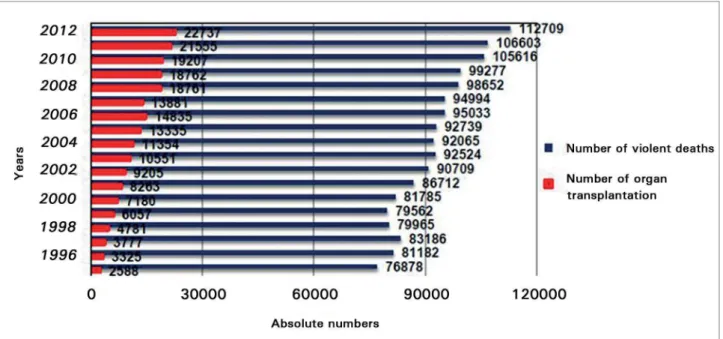L
ETTER| C
ARTA383 Authors
Juliana Gomes Ramalho de Oliveira 1
Marcel Rodrigo Barros de Oliveira 2
Luiza Jane Eyre de Souza Vieira 1
Geraldo Bezerra da Silva Junior 1
1 Programa de
Pós-Graduação em Saúde Coletiva, Universidade de Fortaleza.
2 Serviço de Nefrologia,
Hospital Geral de Fortaleza.
Submitted on: 12/03/2015. Approved on: 01/25/2016.
Correspondence to: Geraldo Bezerra da Silva Junior.
Universidade de Fortaleza - UNIFOR.
Av. Washington Soares, nº 1321, Bloco S, sala S-1 Fortaleza, CE, Brazil. CEP: 60811-905 E-mail: geraldobezerrajr@ yahoo.com.br
Dear Editor,
According to official data published by the Brazilian Ministry of Health and information from the 2013 Map of Violence, the Brazilian Organ Transplant Association, and the Brazilian Organ Transplant Registry, the number of deaths from violent events or external causes has significantly increased in recent years along with the number of organ transplants from deceased donors. Brazil has the fourth highest homicide rate of individuals aged 19 years or younger (13 per 100,000 people) in the world.1
Violent deaths rank third among cause of death in the general population and first for individuals aged 1-39 years.2 The
number of violent deaths increased by 46.6% from 1995 to 2012 (Figure 1). The pooled number includes traffic-related deaths, which alone grew by 38.9%; suicides, with an increase of 56.5%; and
murders, whose number grew by 51.7%.3
Increasing violent deaths and organ transplantation in Brazil:
is there a parallel?
Aumento do número de mortes violentas e transplante de órgãos no
Brasil: há um paralelo?
DOI: 10.5935/0101-2800.20160060
Mortality from violent causes has significantly increased in Brazil, as well as the number of deceased-donor organ transplantation. Although the increase in the number of transplants correlates with higher organ availability, through the increase in potential donors, this is not the unique aspect to be considered. The effective and articulated action of transplantation network seems to be decisive to this outcome.
A
BSTRACTKeywords: brain death; Brazil; mor-tality; tissue donors; transplantation; violence.
A mortalidade por causas violentas tem aumentado de modo significativo no Brasil, bem como o número de transplantes de órgãos com doador falecido. Apesar de o aumento do número de transplantes correlacionar-se com o aumento na disponibilidade de órgãos, por meio do aumento no número de potenciais doadores, este não é o único aspecto a ser considerado. A ação efetiva e articulada das centrais de transplante parece ser decisiva para estes resultados.
RESUMO
Palavras-chave: Brasil; doadores de ór-gãos; mortalidade; morte encefálica, transplante; violência.
In Brazil, heart, liver, lung, pancreas, cornea, and kidney transplants added up to 2,588 procedures in 1995. In 1997, with the establishment of the National Transplant System (SNT), the number went up to 3,777. Since then, the growth of a decentralized network of collaborators operating at a national, regional, and intra-hospital level grew the number of transplants in Brazil to 22,737 in 2012.4
Brazil occupied the eighth place in terms of youth homicide rate (per 100,000 people) from 2008 to 2012, in a list that
included Venezuela (3rd) and Colombia
(4th).3 However, when compared to 54
other countries for number of organ donors per million population, Brazil was
ranked 28th in 2012, ahead of Colombia
(31st) and Venezuela (44th).4 In other
J Bras Nefrol 2016;38(3):383-384 Violent deaths and transplantation
384
Figure 1. Number of violent deaths and transplants in Brazil, 1995-2012.
Although these comparisons shed light on many factors worthy of further investigation, one should not lose sight of the care structure available in Brazil, the demand and supply sides of notifications of deaths and potential organ donors, the improvements in the maintenance protocols provided to donors made possible by the training of emergency and intensive care unit teams, the introduction of new transplant centers, and the role played by awareness-building campaigns designed to educate the population on the importance of organ donation.
The growing and unacceptable level of violence in Brazil seems to contribute to the increase in the number of organ transplants performed in the country. The high number of youth deaths from external causes creates a favorable scenario for organ donation, since in most cases these donors provide for healthy organs. Nevertheless, the growing number of transplant procedures stemming from the greater
availability of organ donors is not the only factor to be considered; the effective job done by the integrated transplant network seems to have been decisive in the materialization of this outcome.
REFERENCES
1. Diniz Filho PR, Lopes G. Youth violence in Brazil: law, prevalence, and promising initiatives. In: Krohn MD, Lane J, eds. The handbook of juvenile delinquency and juvenile justice. Hoboken: John Wiley & Sons; 2015. p. 27-39.
2. Veloso MM, Magalhães CM, Dell'Aglio DD, Cabral IR, Gomes MM. Notification of violence as a strategy for health surveillance: profile of a metropolis in Brazil. Ciênc Saúde Colet 2013;18:1263-72. DOI: http://dx.doi.org/10.1590/ S1413-81232013000500011
3. Brasil. Secretaria-Geral da Presidência da República, Secretaria Nacional da Juventude. Homicídios e Juventude no Brasil. Mapa da violência 2013. Brasília: Secretaria-Geral da Presidência da República; 2013.
